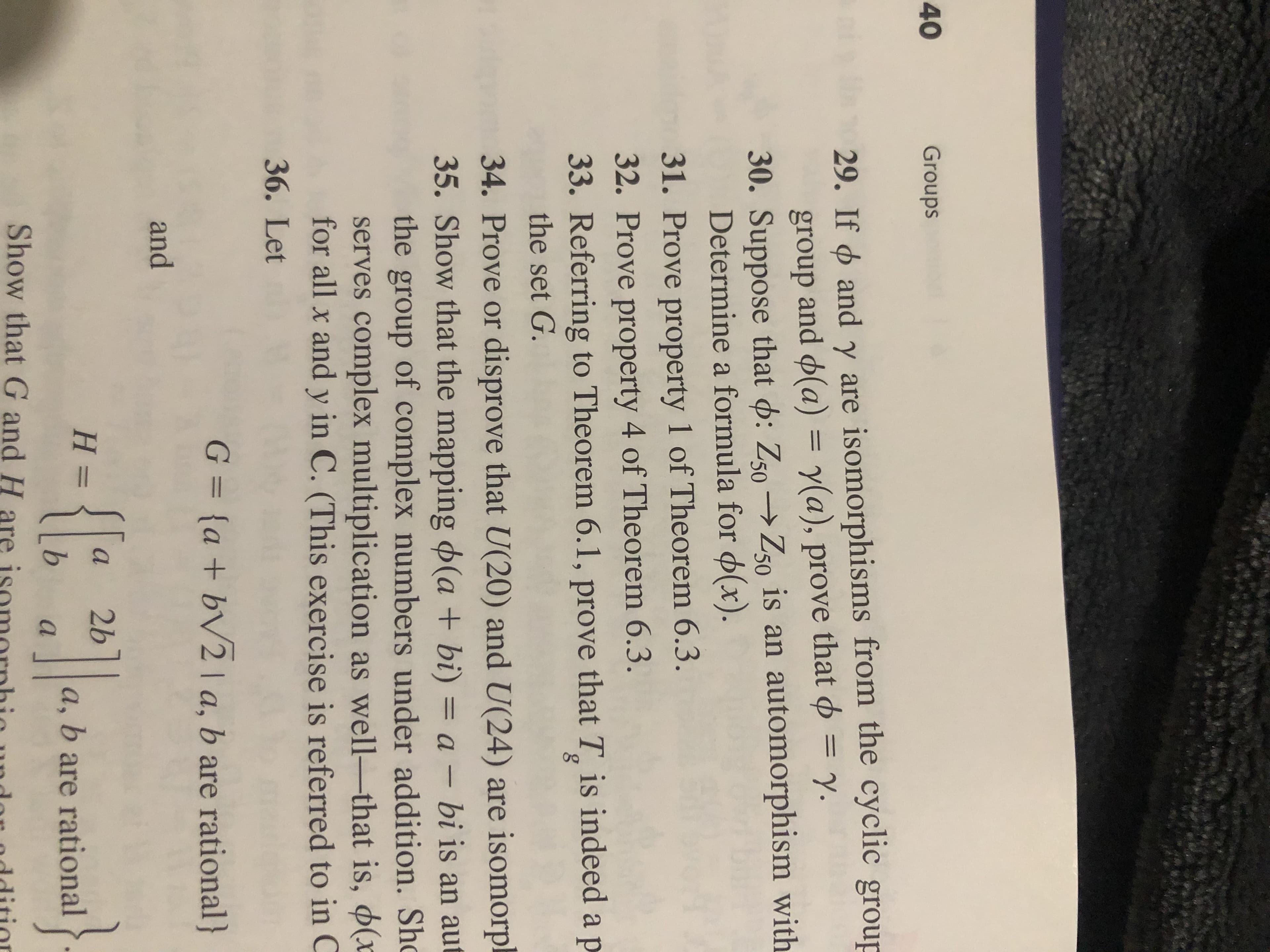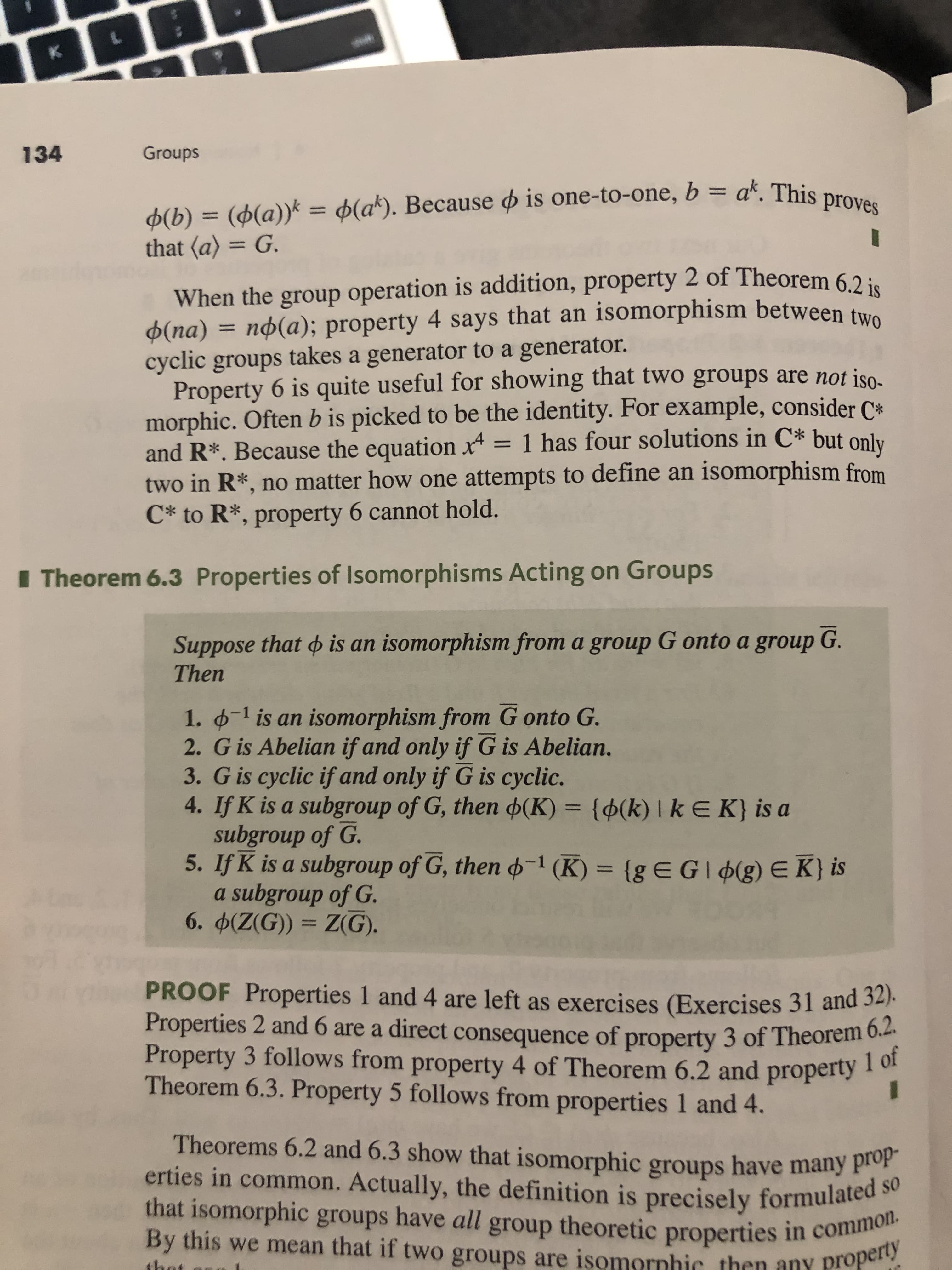40 Groups 29. If and y are isomorphisms from the cyclic group group and d(a) = y(a), prove that y. 30. Suppose that : Z50Z50 is an automorphism with Determine a formula for d(x). 31. Prove property 1 of Theorem 6.3. 32. Prove property 4 of Theorem 6.3. 33. Referring to Theorem 6.1, prove that T is indeed a p the set G. 34. Prove or disprove that U(20) and U(24) are isomorp 35. Show that the mapping o (a + bi) = a - bi is an aut the group of complex numbers under addition. Sho serves complex multiplication as well-that is, (x for all x and y in C. (This exercise is referred to in C 36. Let G = {a+ bV2 l a, b are rational} and 2b a, b are rational a Н- а Show that G and H K 134 Groups ((a)) = (ak). Because is one-to-one, b = a*. This proves (b) that (a) = G. When the group operation is addition, property 2 of Theorem 6.2 is np(a); property 4 says that an isomorphism between two Ф(па) cyclic groups takes a generator to a generator. Property 6 is quite useful for showing that two groups are not iso morphic. Often b is picked to be the identity. For example, consider C and R*. Because the equation x = 1 has four solutions in C* but only two in R*, no matter how one attempts to define an isomorphism from C* to R*, property 6 cannot hold. Theorem 6.3 Properties of Isomorphisms Acting on Groups Suppose that o is an isomorphism from a group G onto a group G. Then 1. 1 is an isomorphism from G onto G. 2. G is Abelian if and only if G is Abelian. 3. G is cyclic if and only if G is cyclic. 4. If K is a subgroup of G, then (K) = {¢(k) | k E K} is a subgroup of G. 5. If K is a subgroup of G, then 1 (K) {g EGI(g) e K} is a subgroup of G. 6. d(Z(G)) Z(G). PROOF Properties 1 and 4 are left as exercises (Exercises 31 and 32). Properties 2 and 6 are a direct consequence of property 3 of Theorem 6.2. Property 3 follows from property 4 of Theorem 6.2 and property 1 of Theorem 6.3. Property 5 follows from properties 1 and 4. Theorems 6.2 and 6.3 show that isomorphic groups have many prop- erties in common. Actually, the definition is precisely formulated so that isomorphic groups have all group theoretic properties in common. By this we mean that if two groups are isomornhic then any property 1h
40 Groups 29. If and y are isomorphisms from the cyclic group group and d(a) = y(a), prove that y. 30. Suppose that : Z50Z50 is an automorphism with Determine a formula for d(x). 31. Prove property 1 of Theorem 6.3. 32. Prove property 4 of Theorem 6.3. 33. Referring to Theorem 6.1, prove that T is indeed a p the set G. 34. Prove or disprove that U(20) and U(24) are isomorp 35. Show that the mapping o (a + bi) = a - bi is an aut the group of complex numbers under addition. Sho serves complex multiplication as well-that is, (x for all x and y in C. (This exercise is referred to in C 36. Let G = {a+ bV2 l a, b are rational} and 2b a, b are rational a Н- а Show that G and H K 134 Groups ((a)) = (ak). Because is one-to-one, b = a*. This proves (b) that (a) = G. When the group operation is addition, property 2 of Theorem 6.2 is np(a); property 4 says that an isomorphism between two Ф(па) cyclic groups takes a generator to a generator. Property 6 is quite useful for showing that two groups are not iso morphic. Often b is picked to be the identity. For example, consider C and R*. Because the equation x = 1 has four solutions in C* but only two in R*, no matter how one attempts to define an isomorphism from C* to R*, property 6 cannot hold. Theorem 6.3 Properties of Isomorphisms Acting on Groups Suppose that o is an isomorphism from a group G onto a group G. Then 1. 1 is an isomorphism from G onto G. 2. G is Abelian if and only if G is Abelian. 3. G is cyclic if and only if G is cyclic. 4. If K is a subgroup of G, then (K) = {¢(k) | k E K} is a subgroup of G. 5. If K is a subgroup of G, then 1 (K) {g EGI(g) e K} is a subgroup of G. 6. d(Z(G)) Z(G). PROOF Properties 1 and 4 are left as exercises (Exercises 31 and 32). Properties 2 and 6 are a direct consequence of property 3 of Theorem 6.2. Property 3 follows from property 4 of Theorem 6.2 and property 1 of Theorem 6.3. Property 5 follows from properties 1 and 4. Theorems 6.2 and 6.3 show that isomorphic groups have many prop- erties in common. Actually, the definition is precisely formulated so that isomorphic groups have all group theoretic properties in common. By this we mean that if two groups are isomornhic then any property 1h
Elements Of Modern Algebra
8th Edition
ISBN:9781285463230
Author:Gilbert, Linda, Jimmie
Publisher:Gilbert, Linda, Jimmie
Chapter3: Groups
Section3.1: Definition Of A Group
Problem 46E: In Example 3, the group S(A) is nonabelian where A={ 1,2,3 }. Exhibit a set A such that S(A) is...
Related questions
Concept explainers
Contingency Table
A contingency table can be defined as the visual representation of the relationship between two or more categorical variables that can be evaluated and registered. It is a categorical version of the scatterplot, which is used to investigate the linear relationship between two variables. A contingency table is indeed a type of frequency distribution table that displays two variables at the same time.
Binomial Distribution
Binomial is an algebraic expression of the sum or the difference of two terms. Before knowing about binomial distribution, we must know about the binomial theorem.
Topic Video
Question
32.

Transcribed Image Text:40
Groups
29. If and y are isomorphisms from the cyclic group
group and d(a) = y(a), prove that y.
30. Suppose that : Z50Z50 is an automorphism with
Determine a formula for d(x).
31. Prove property 1 of Theorem 6.3.
32. Prove property 4 of Theorem 6.3.
33. Referring to Theorem 6.1, prove that T is indeed a p
the set G.
34. Prove or disprove that U(20) and U(24) are isomorp
35. Show that the mapping o (a + bi) = a - bi is an aut
the group of complex numbers under addition. Sho
serves complex multiplication as well-that is, (x
for all x and y in C. (This exercise is referred to in C
36. Let
G = {a+ bV2 l a, b are rational}
and
2b
a, b are rational
a
Н-
а
Show that G and H

Transcribed Image Text:K
134
Groups
((a)) = (ak). Because is one-to-one, b = a*. This proves
(b)
that (a) = G.
When the group operation is addition, property 2 of Theorem 6.2 is
np(a); property 4 says that an isomorphism between two
Ф(па)
cyclic groups takes a generator to a generator.
Property 6 is quite useful for showing that two groups are not iso
morphic. Often b is picked to be the identity. For example, consider C
and R*. Because the equation x = 1 has four solutions in C* but only
two in R*, no matter how one attempts to define an isomorphism from
C* to R*, property 6 cannot hold.
Theorem 6.3 Properties of Isomorphisms Acting on Groups
Suppose that o is an isomorphism from a group G onto a group G.
Then
1. 1 is an isomorphism from G onto G.
2. G is Abelian if and only if G is Abelian.
3. G is cyclic if and only if G is cyclic.
4. If K is a subgroup of G, then (K) = {¢(k) | k E K} is a
subgroup of G.
5. If K is a subgroup of G, then 1 (K) {g EGI(g) e K} is
a subgroup of G.
6. d(Z(G)) Z(G).
PROOF Properties 1 and 4 are left as exercises (Exercises 31 and 32).
Properties 2 and 6 are a direct consequence of property 3 of Theorem 6.2.
Property 3 follows from property 4 of Theorem 6.2 and property 1 of
Theorem 6.3. Property 5 follows from properties 1 and 4.
Theorems 6.2 and 6.3 show that isomorphic groups have many prop-
erties in common. Actually, the definition is precisely formulated so
that isomorphic groups have all group theoretic properties in common.
By this we mean that if two groups are isomornhic then any property
1h
Expert Solution
This question has been solved!
Explore an expertly crafted, step-by-step solution for a thorough understanding of key concepts.
This is a popular solution!
Trending now
This is a popular solution!
Step by step
Solved in 4 steps with 4 images

Knowledge Booster
Learn more about
Need a deep-dive on the concept behind this application? Look no further. Learn more about this topic, advanced-math and related others by exploring similar questions and additional content below.Recommended textbooks for you

Elements Of Modern Algebra
Algebra
ISBN:
9781285463230
Author:
Gilbert, Linda, Jimmie
Publisher:
Cengage Learning,

Elements Of Modern Algebra
Algebra
ISBN:
9781285463230
Author:
Gilbert, Linda, Jimmie
Publisher:
Cengage Learning,